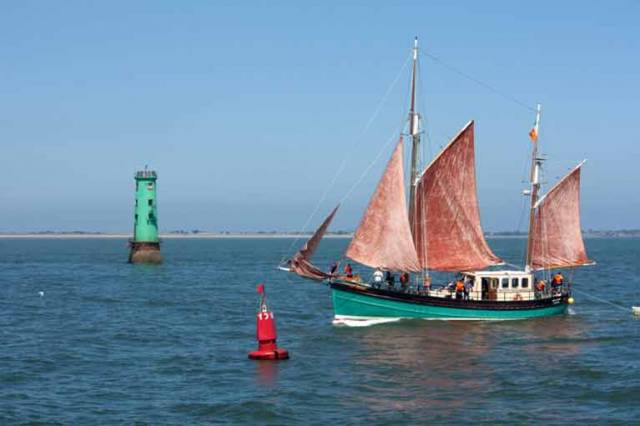Tony McLoughlin, owner and operator of the ketch Brian Ború, recounts an epic series of sail training voyages that took the “fantastic little ship” on a circumnavigation of Ireland last summer
The sailing ship Brian Ború is a beautiful wooden-hulled, traditionally built and rigged gaff ketch. Descended from the legendary sailing drifters of the late 19th century, she is a roomy and powerfully built vessel of 40 tons displacement and 20 metres overall length, originally launched in 1961. Following a Leader-funded restoration and conversion project in 2014, she now operates under Irish licence as the sole passenger and sail training vessel of her type around the island of Ireland, carrying up to 12 passengers and three crew – a sturdy and able ‘small tall ship’ in the true spirit of our much loved Asgard 2.
Following an appearance at the Cobh Traditional Boat Festival in June 2015, I (the operator) was approached by Michael Byrne of Sail Training Ireland to undertake sail training voyages administered by them on the Brian Ború around the Irish coast. After an upgrade of her accommodation and licence over the winter of 2015, the ketch commenced sail training voyages in June 2016, carrying young Irish people from 15 to 30 years of age. The vessel was an immediate success, providing a safe yet challenging experience for young people from all backgrounds, irrespective of class or gender. The 2016 season was a good start for the Brian Ború as a sail training ship.
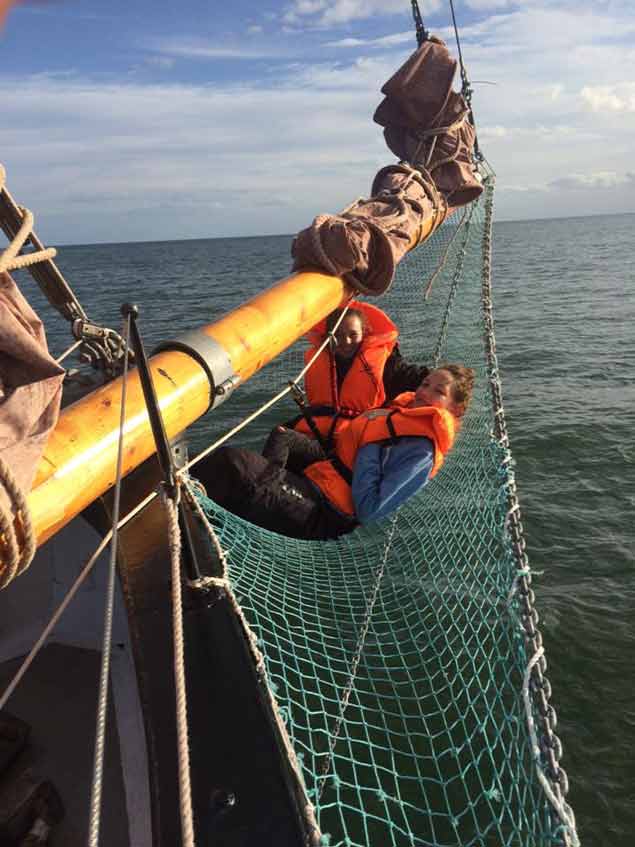 Trainees take a break on board the Brian Boru ketch Photo: Traditional Boat Charters/Facebook
Trainees take a break on board the Brian Boru ketch Photo: Traditional Boat Charters/Facebook
The first of June 2017 saw the mighty Brian Ború set out on the first leg of an eventual circumnavigation of the island of Ireland. Departing at 4am from her home port of Waterford, the vessel and delivery crew quickly settled into the four-hour watch routine on a ‘shakedown’ cruise up to Dublin.
The secret of making a safe, swift and comfortable trip eastwards from Hook Head, past Kilmore Quay and the Saltee Islands, around Carnsore Point, and then northwards to Dublin, is in the passage planning. Skipper Peter Scallan of Wexford knew this very well and timed the voyage to perfection. On a broad reach eastwards, the tide helped pull us around Carnsore Point, then a gentle gybe allowed the Brian Ború to run ahead of the wind northeastwards past Rosslare and then further north along the Wexford coast towards Wicklow Head, still with a good tide in our favour.
Running before the wind in a gaff-rigged, canoe-sterned, heavy displacement wooden ketch can be a joyous experience. The long keel and easy run aft combine to allow the vessel to steer comfortably, with little giddiness or shearing away. This is particularly true when the wind is slightly on the quarter, which it was. When you happen to look up at the massive sheeted out main and mizzen sails, you get a true feeling of the power of a gaff rig, with the maze of sheave blocks and running rigging suddenly making sense. The backstays, the peak halliards, the topping lifts, the throat halliards, the preventers, the mainsheets all working in harmony to support the great bellies of the main and mizzen sails. The easy yet continuous swaying motion against the backdrop of the blue summer sky, could hypnotise you into believing that you were back in the Age of Sail, where engines were unknown.
Following a stop-off in Wicklow Harbour, we sailed again with the tides along the coast inside the Arklow Banks, with their impressive stand of wind turbines; north past Bray Head; through the gorgeous Dalkey Sound; and into the historic and picturesque Dublin Bay.
With logical and clear instructions from Dublin Port control, we took our place in the Parade of Sail among the tall ships coming into Dublin Port for the city’s annual Riverfest. In bright sunshine, it was a magnificent feeling to be part of a great display of seamanship as these beautiful vessels made their way under sail right into the Liffey. The skill of the captains and crews of these traditional vessels was evident as, one after another, we dropped sail and went alongside to our allotted berths on the North Wall. No showmanship, just good solid maritime teamwork.
Dublin Riverfest was host to a selection of traditional sailing vessels and classic tall ships, from the magnificent Earl of Pembroke to the pirate ship Phoenix to the classic ketch Maybe, with many more vessels in between, and with the Brian Ború proud to be present as the sole Irish-flagged sail training vessel. Another Irish vessel present was the Irish Whale and Dolphin Group’s ketch Celtic Mist. The Oliver Hart-operated Spirit of Oysterhaven was sadly missed, but she was otherwise engaged in an Atlantic crossing.
On the Sunday afternoon we welcomed onboard our group of trainees from Sail Training Ireland’s Drogheda Bursary Scheme. Following introductions, safety procedure instructions, accommodation and watch assignments, our 10 new crew members relaxed and happily made themselves at home, initial shy nerves quickly dissipating. Sunday evening was devoted to enjoying the last night of the Dublin Riverfest, and fun was had by all.
Monday morning and normal sail training ship routines kicked in: breakfast, then ‘happy hour’ cleanup, then captain’s inspection were completed. Our allotted time for departing the port with the other tall ships was noon, so the intervening time was used to refresh safety procedures, hoist and lower sails, and generally introduce the trainees to as much as possible on the vessel in the calm waters of the berth
We departed the River Liffey under engine, joining the exiting parade of ships. As we passed Poolbeg Marina, the sails were hoisted by our trainee crew in the following order: Mizen; Main; Staysail; and Jib. Already, the looks on the faces of these 10 young people showed how self-confidence, of the best kind, is immediately instilled through teamwork on a sail training vessel, as the red canvas sails billowed powerfully out to starboard. On reaching clearwater we bade farewell to the fleet and set a course southwards.
Changeable weather was forecast for the week, northerlies for the early part and westerlies for the latter expected. Accordingly, our passage plan needed some changes. But this is the real beauty and pleasure of coastal voyaging in a sail training vessel like the Brian Ború. Her moderate draft of 2.5 metres allows the vessel to access most Irish ports, big and small, and so we chose to visit the very pleasant and welcoming port of Wicklow once again. A freshening northeasterly wind allowed the Ború to really ‘lift her skirts’ on a broad reach down to Wicklow.
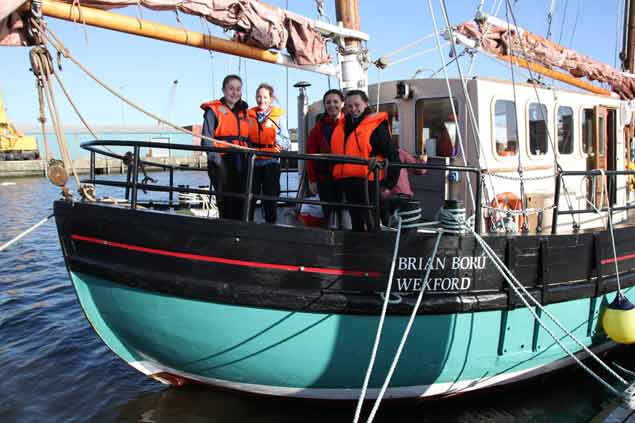 Young trainees on the Brian Boru ketch
Young trainees on the Brian Boru ketch
Our young crew were excited and exhilarated by such a fantastic first day at sea. To really cap it off we were invited to join an ‘open mic’ evening in Wicklow Sailing Club, with three of our trainees delighting the audience with songs.
Next morning, an invitation to visit the Wicklow RNLI station was eagerly accepted and enjoyed by everybody. The weather had badly deteriorated and so the day was spent in port. But boredom was never an issue with swimming in the harbour, diving from the bowsprit, fishing for mackerel, learning to row the ship’s boat, learning basic navigation, knot-tying, engine maintenance, cooking, and generally ‘chilling’ being the main occupations.
What many of us take for granted — being used to the sea, sailing, or boating in general — is often totally unknown and fascinating for these young sail trainees from all backgrounds. Sail Training Ireland is to be complimented on its current policy of making voyages accessible to all young people, of carefully choosing a cross section of the population for its trips at sea, and ensuring inspirational social integration.
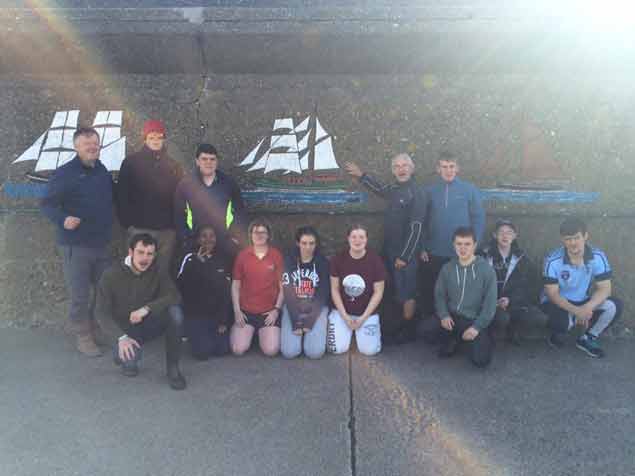 Under Asgard 2 in Wicklow Harbour
Under Asgard 2 in Wicklow Harbour
The rest of the weeks’ voyage proved to be exceptional, with the vessel sailing back northwards exploring Ireland’s Eye, Lambay, Howth, and finally entering the ancient River Boyne, dividing the counties of Meath and Louth, and up to the historic Port of Drogheda.
Midday Friday saw our trainees packing up and leaving the vessel, but only temporarily. RTÉ Nationwide programme was filming the Irish Maritime Festival being held over the weekend in Drogheda and the Brian Ború had been asked to sail down the Boyne Estuary with the film crew on board. What an opportunity for the young trainees to return to the ship early on Saturday morning, to cast off the lines and raise the sails whilst being filmed for a national television show. They expertly raised, then lowered and furled the sails, then took the mooring lines and efficiently tied the vessel back alongside. In a short sail training week, these young people had not only learned the basics of sailing the ship, but also experienced real teamwork first-hand, and consequently gained hugely in self-esteem, self-confidence and social skills. Every young person should have such an opportunity.
The ‘little ship’ Brian Ború was kept busy during the weekend in Drogheda plying up and down the estuary, bringing various groups out on the river for a traditional sail experience. For many, it was their first time to see their hometown from the water. Great hospitality was shown to the crew by the festival organisers as we thoroughly enjoyed the festivities on Saturday evening and had the opportunity to reunite with the crews of many of the ships from the Dublin Riverfest. A hard life!
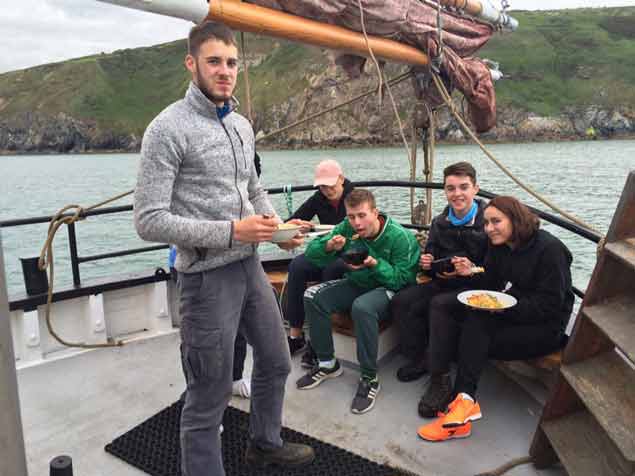 Lunch at Lambay Island
Lunch at Lambay Island
Sunday afternoon saw the arrival of the next group of trainees from the Drogheda Bursary Scheme and our crew, now with Captain Victor Whitty in command, kicked into action once again with our introduction procedures. On Monday, we cast off yet again and sailed down the river with the fleet to cross out over the Boyne Bar on the high tide. All sails set we turned southwards in a good fresh westerly breeze. The week flew by, with the vessel adventuring down to the magnificent Dublin Bay area, overnighting at Poolbeg Marina; anchoring off Lambay Island; thundering up to Carlingford Lough, overnighting in Warrenpoint, and finishing finally in Carlingford Marina on Friday 16 June. Another fantastic week with inspired young Irish trainees, albeit in very changeable weather.
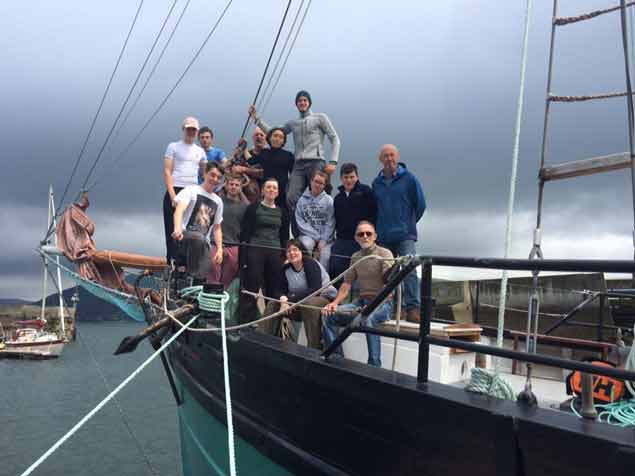 In Carlingford Marina
In Carlingford Marina
The next ‘job’ for the ship was on Belfast Lough at its own Maritime Festival, starting on Saturday morning 17 June. With no time to lose, we departed Carlingford Lough, the magnificent scenery of the Mournes on the northern shore and the legendary Cooley Mountains to the south, and headed up along the Co Down coastline, past Strangford Lough and towards the mouth of Belfast Lough. Night had fallen, but we decided to proceed right in to the Port of Belfast. A well-lit channel and a decent Raymarine plotter on board allowed us to confidently proceed up the Lagan to our berth in the Titanic Quarter. We swung around to starboard and went portside alongside on the pontoon. We smiled to find ourselves astern of the pirate ship Phoenix once again – truly déjà vu!
Two days of taking young people out on Belfast Lough for a traditional sail experience, socialising with the organisers and with our friends on the other ships, and it was time to set sail once again for our next charter in Sligo. With a delivery crew of three, the Brian Ború motored gently off her berth in the Titanic Quarter and downriver past the busy commercial docks. It was inspiring to see massive conical sections of giant wind turbines being carefully loaded on to waiting ships. Nowadays, instead of shipbuilding, the well known Harland and Wolff company is engaged, apparently, in the building of these columns for wind turbines. A sign of the times, for sure.
Down the estuary, leaving Bangor on our portside, we rounded northeast and then north. The sun was shining and a nice Force 4 to 5 was blowing, but from right ahead. We accepted our fate and resigned ourselves to motoring along the coast at six knots, with our trusty Volvo Penta 6 cylinder diesel thumping out her steady rhythm. Checking our position on the chart, we grinned to find ourselves 11 nautical miles from Rathlin Island and just 10 from the Mull of Kintyre and Scottish shores. It is no wonder that the traditional links between Ireland’s orthern counties and Scotland are so close. A strong giant could nearly hurl a rock from one shore to the other.
Having made good time along the ruggedly beautiful Antrim and Derry coastlines and with darkness falling, we overnighted and refuelled in Greencastle, Co Donegal. The wind was still not co-operating as we turned to the northwest next morning; it stayed steadily on our bows. But we pushed on towards Tory Island. Alas, even with the wind gradually coming around in our favour, we had the misfortune of running over a long floating potting rope. Our delivery skipper Oisín Cahill immediately slammed into neutral, but the rope was well and truly wrapped on our propeller shaft. The culprit fishing vessel came to help us and managed to get a large quantity of the rope out. Nevertheless we had an uneasy feeling about what possible damage had been done.
We gingerly motor-sailed ahead under mizzen and staysail until a second mishap befell us. The motor began to lose revs for no reason. We stopped it and sailed on while checking for an airlock or other possible explanation. Diesel engines need only air and fuel to keep running and our experience told us to check for these – no apparent fault. We tried the ignition again and she started up as normal, but when she seemed to slightly stall again we decided to call for assistance. Mevagh inshore RNLI rib and Lough Swilly all-weather RNLI vessel came rapidly alongside and advised us to proceed in to Mevagh Boatyard to check things out. This was, of course, the perfect course of action, and both vessels accompanied us as we motored gently up the winding creek to the safety of a calm anchorage just off the boatyard.
The friendly welcome we received from both lifeboat crews was a real credit to the RNLI and to the Donegal people. Tea, coffee, biscuits and even a tour of the most up-to-date offshore lifeboat imaginable was given to us in the Mevagh RNLI station, before we were ferried back to welcoming bunks on the Brian Ború.
A diver and a mechanic rowed out to us first thing in the morning from the boatyard. The diver reported no apparent damage to the stern gear or rudder, but the mechanic reported a faulty connection on the fuel line which was air-locking the system. This replaced, he waved us off on the high tide back out of the channel. The wind had rounded once more into the west and therefore onto our bows and so we motored on westwards through Tory Sound, past the Bloody Foreland, and eventually round the coast of Donegal to the Port of Sligo and new adventures.
Sunday afternoon, 25 June, and a group of young people from the Safehaven Ireland organisation joined the ship. Yet again, the crew kicked into gear with the essential introductory procedures. We were honoured to welcome the excellent Captain Liam Keating as guest captain for the two upcoming West Coast voyages. A native of Waterford, Liam has been a true inspiration to the sail training world ever since his early days as mate on Asgard 2, then captain of the Prince William, and for many years captain of the Stavros Niarchos. Needless to say, the Brian Ború performed admirably under the command of Capt Keating, and he was heard to mutter to himself “What a fantastic little ship.” Keeping a close eye on the weather, we explored the coast right down into Galway Bay.
Hugely memorable was our visit to Clare Island, formerly home to the ‘pirate queen’ Grainne Uaile, whose castle still stands in the lee of the hill just beyond the harbour. Such was our welcome that the community hall was opened for us to use showers and laundry facilities, and play billiards. Crystal-clear seawater and a genuine smiling welcome are the author’s memories of Clare Island.
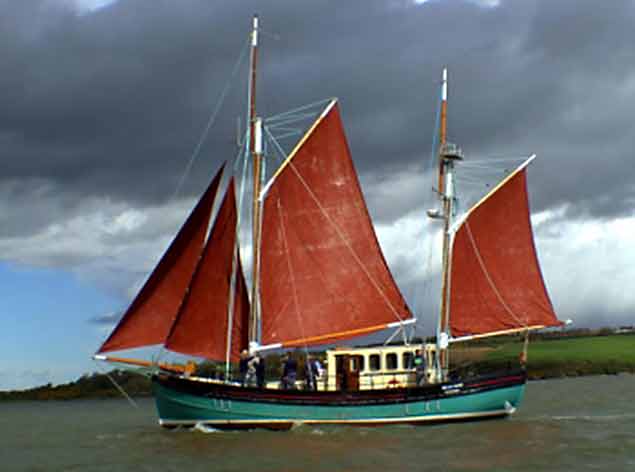 The ketch Brian Boru under full sail
The ketch Brian Boru under full sail
With deteriorating weather, we sailed into Arranmore and found a good sheltered berth for the night. While it would have been fun and interesting to explore the area the next day, the weather dictated that we should sail for Galway City without delay. So we said ‘slán’ to the island, hoisted the sails and ran before the mounting wind into Galway.
What a busy scene awaited us, as the Port of Galway was already into the colourful early stages of the SeaFest weekend. Capt Keating showed us great seamanship as he manoeuvred the vessel, in a tightly packed harbour, using the gusting wind to our berth alongside the Celtic Mist. A bowsprit is a wonderful spar and adds great beauty to a vessel, but sometimes in a crowded port it would be useful if it could be retracted, or pivoted up from its inboard end, as is very common in French traditional vessels.
SeaFest in Galway was a colourful and informative gathering, and our crew had the pleasure of resting and enjoying the festival. But Sunday afternoon came quickly and the new trainees for the week arrived on board. Monday morning saw the Brian Ború sailing out through the lock gates of Galway Port and heading west towards Inisheer, one of the Aran Islands. A large group of dolphins had been sighted there a few days beforehand and we were hoping to sail with them as well as visiting the island. However, our plans had to change once again due to an approaching weather front. With darkening skies, we sailed into sheltered waters in Blacksod Bay and dropped anchor for the night. With first light, our young crew winched in the anchor and we set a southerly course for Loop Head and the Shannon Estuary.
Discretion was the better part of valour and Capt Keating’s decision to sail directly down past Loop Head and across the mouth of the Shannon to the shelter of Fenit Harbour was exactly the right one, with heavy southwesterly seas developing overnight. The ensuing days were like pages from a tourist brochure, with us swimming, mackerel fishing, sailing around Brandon Bay, dolphin watching, exploring the hinterland, and anchoring overnight against a backdrop of stunning Kerry scenery. The final leg of our passage took us back over towards Loop Head and along the ancient cliffs, up the Shannon to the lock-gated Kilrush Marina, and Friday 7 July marked the end of yet another sail training adventure.
Our young trainees departed, and a group of friends of the Brian Ború found their way to Kilrush to help sail the ship back, once more under Capt Whitty, to her home berth in Waterford. What a stunning voyage, across the turbulent seas which greeted us at the Shannon mouth, through the Blasket Sound and into the calm waters of Dingle Harbour. The following morning, Fungie the famous dolphin swam to our bows as we departed on our way east. Our decision to ‘heave to‘ for lunch at the Skelligs was a great one. It was truly a spiritual feeling to drift gently in the lee of Skellig Michael. On again to an overnight stay in Castletownbere Harbour – good food and a boisterous sing-song!
We continued eastwards the following day, past the Fastnet Rock to anchor with a glorious setting sun off Glandore. Our final day saw the mighty Brian Ború surging along in bright sunshine and a fine southerly breeze past Cork Harbour and on to Dunmore East. The wind gradually swung to the west and carried us on a broad reach upriver past Hook Head, Creadon Head and up to Duncannon on the Wexford shore. Sails lowered and furled, we motored gently upriver past Passage East, Ballyhack and Cheekpoint to our home berth on the marina in Waterford City. By 13 July, our circumnavigation of the island of Ireland was completed.
The 2017 sail training season had other adventures in store for the Brian Ború, bringing two further weeks of voyages with trainees from Sail Training Ireland’s Waterford Bursary Scheme, plus a late season three-day voyage from Dublin to Warrenpoint and back. This latter voyage was a charter for The Atlantic Youth Trust, whose director Neil O’Hagan had managed to organise a voyage socially integrating young people from both sides of the border. The BBC series Songs of Praise also spent a day filming the young crew as they sailed aroundngford Lough on the Brian Ború which, when not on voyages around the coast, was kept busy taking groups out on the historical waters of the Waterford Estuary.
Looking back on 2107 and on the year before, it really has been a great privilege to introduce young Irish people to the beauty of our coasts, to the supreme emotion of living and sailing in a powerful traditional vessel, and to the self-discovery which is an automatic result of the sail training experience. In this author’s humble opinion, this type of sail training is about much more that skills learning, it is about giving young people an opportunity to express themselves, discover themselves, and to develop themselves in an atmosphere which removes much of the normal peer group pressure, and which promotes respect for themselves and others. All this in a short five- or six-day voyage which can be really challenging, but which has been shown to change lives, in the very best way.
Sail Training Ireland for Youth Development is working hard to develop bursary schemes around the country, securing funding from port authorities, city and county councils, corporate and many other sources, so that more and more young people can avail of this fantastic experience. Such a positive educational opportunity should definitely be recognised for Government funding.
The current CEO of Sail Training Ireland, Daragh Sheridan, is working tirelessly with his team of Sindy and Judy to organise as many voyages as possible with a range of big and small tall ships for the 2018 season. Please support them in any way you can. Fair winds in 2018, and hopefully you too will get a chance to sail on the mighty Brian Ború.



























